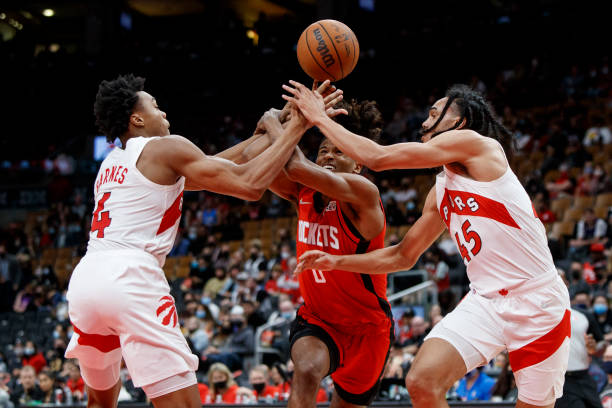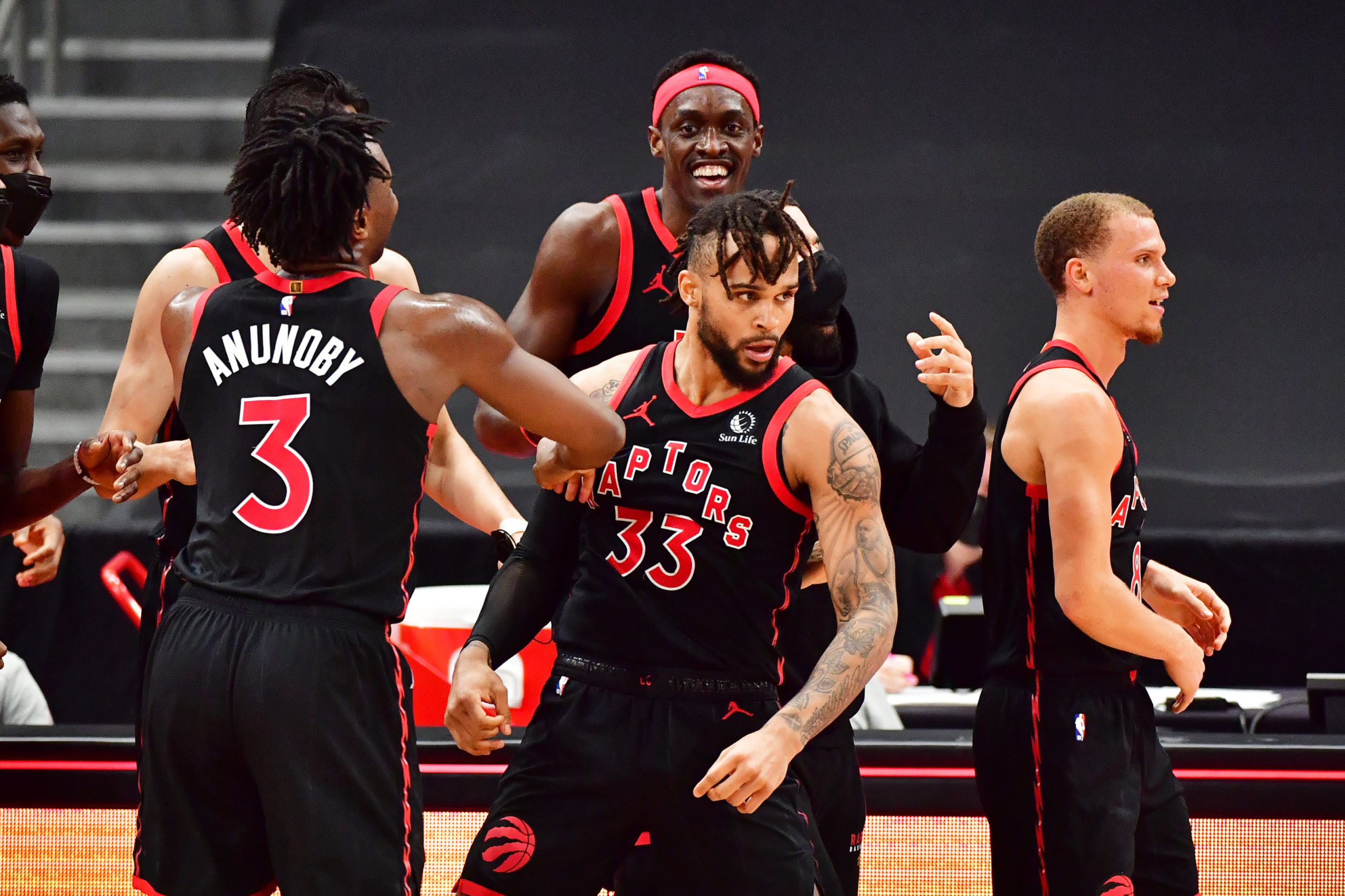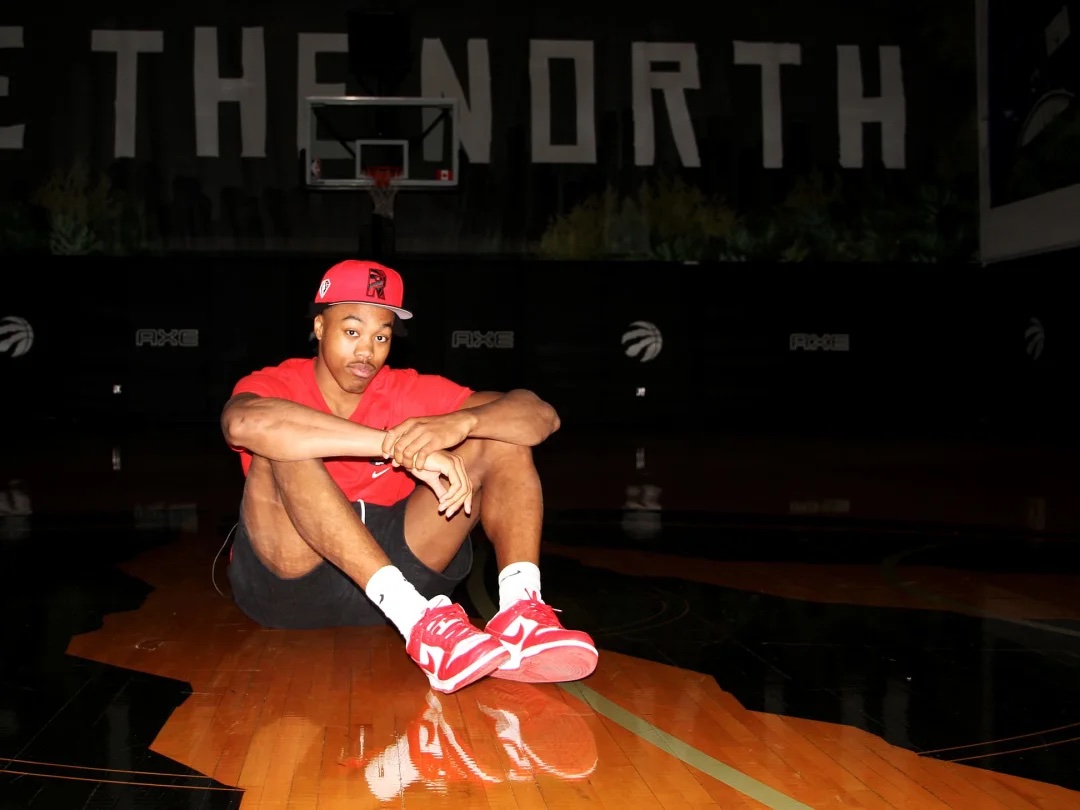1. Precious Achiuwa is ready. Not necessarily ready to play winning basketball minutes whenever he’s on the court. But he’s ready to make exceptional, value-added plays.
You can count the number of centers who can protect the rim, attack off the bounce, and shoot on one hand. (In fact, judging based on centers who shot 50 percent or better on two or more drives per game, shot 36 percent or better on two or more threes per game, and held opponents to their average or worse while protecting the rim five times or more per game, only Karl-Anthony Towns and Joel Embiid fit the bill.) Obviously, don’t expect Achiuwa to reach those numbers. But he does drive, shoot, and protect the rim. That’s extraordinarily rare for a center on its own. If he starts doing them all well, it would be even more ridiculous.
Of course, Achiuwa was not consistently such a three-headed monster during the preseason. While he had some highlights in all three categories, he likely didn’t reach any of those categories. He drove plenty but settled taoo often for pull-up jumpers, or else never created separation from opposing centers and forced difficult layups. He didn’t hesitate to shoot from deep, but he only connected on 22.2 percent. Though he had some exceptional blocks and occasional bouts of rim protection, too often he stuck with his man in the pick and roll and allowed guards to explode to the rim untethered.
But Achiuwa isn’t a finished player by any means. Ability is more important at age 22 than consistency. You can bet he won’t join Towns and Embiid on that list this year. But he has a player archetype, and if everything goes right, he could get there one day. This year is about stretching his wings and seeing what he can do. Some games, he’ll grab the rebound and knife through everyone. Other games, he’ll get back cut and not know it until the ball is already being inbounded. (Hell, in plenty of games, he’ll do both.)
That Achiuwa is showing ability in such diverse areas is a huge plus for Toronto. He averaged 2.0 steals per game in the preseason, and he’s capable of running the fastbreak on his own after snatching the ball away. Almost a third of his field goals were unassisted, which would have ranked second among all centers last year. That he can create for himself gives Toronto a weapon at center it hasn’t wielded since Serge Ibaka.
Furthermore, mistakes like getting back cut generally go away once you’re used to the NBA. Most bigs eventually learn how to guard the pick and roll, particularly ones with such outrageous athletic abilities as Achiuwa. Those flaws constitute his floor, and they’ll certainly cause lost minutes and occasional frustrations this year. But his being able to do things that other centers can’t is far, far more important at this stage and into the future for Toronto. The Raptors should force feed him minutes. Achiuwa could end up being a critical piece of a championship contending squad in the future.
2. Who starts at shooting guard for Toronto? The obvious choice was Gary Trent jr. for 54 million reasons. He offers shooting that no one other than Fred VanVleet can offer. But then Goran Dragic started games whenever available during preseason, and he both threatens the midrange and rim far better than the non-VanVleets at the guard position, and he could also bring in a small haul via trade if showcased properly. Smart observers saw the value Dragic could bring to this Raptors squad years ago if he isn’t traded.
But preseason muddied the situation as much as clarified it. Trent can shoot, sure, but through most of preseason, he offered exceptionally little on the court. (Disclaimer: 22-year-olds usually get better at almost everything over time.) He doesn’t just die on screens; he experiences Shakespearean deaths that involve him throwing his head back, jumping out of position, waving his arms, and offering small soliloquies generally to the point of “Behold, O! I am slain!” Trent had a few nice defensive stands that saw him collect deflections, but too often he was out of position. On the other hand, Dragic shot horribly from the floor (Trent shot atrociously from deep) and generally couldn’t create as much separation as he could a few years ago. If age has sapped Dragic’s explosiveness in the heart of the floor, then he may not offer enough offensive benefits against starters to justify playing him large minutes.
Which leaves Toronto in a quagmire. Svi Mykhailiuk shot over 40 percent from deep over preseason and showed some off-the-dribble and passing chops. Maybe Scottie Barnes can make up for his lack of range with smart cutting and passing, and he can start at a guard spot, which lets Toronto dip into its (when healthy) relatively larger stable of rotation-caliber forwards to start at power forward. If Malachi Flynn had shown growth coming into the year, he could also have a big on the starting job. Alas too much of his effectiveness at the moment depends on whether his jumper is falling or not.
Frankly, the Raptors have a four-player core at the moment, and three of them play the same position. That will be less important for the next few weeks until Pascal Siakam returns, but then Toronto will have some rotation juggling to do. Having a starting-caliber shooting guard who could help on both ends would help keep those balls in the air. One of Trent, Dragic, or Flynn should seize the spot and run with it. If they don’t, it will be hard to keep Barnes off the floor, no matter what position he’s nominally asked to play.
3. What is Scottie Barnes on the offensive end? Barnes can pass from the high post, on the break (no-look bounce passes, hello!), in the pick and roll as the handler or the roller. He can finish up and over opponents if he gets a two-footed jump, and he can one-handed hammer in transition over contests from the side. He’s got nifty little one-hand push shots that allow him to use his outrageous extension to play keepaway from almost any defender. He can handle, but his brain can drive a gear or two ahead of his hands, meaning he can think himself into turnovers when he sees pressure.
That’s still a lot of tools. At the same time, opponents can fluster him by just … not guarding him at all. When he’s uncontested at the three-point arc, his knee-jerk reaction seems to be to dribble into a midranger that’s more contested than a triple would have been. He hasn’t hit a lot of shots that don’t involve him getting into rhythm first. (To that point, he seems to be a better pull-up shooter than standstill shooter, which: he plays like Giannis Antetokounmpo in more ways than one.) He could just shoot the three. Or better yet, he could take some pages from Draymond Green’s playbook.
Green and Steph Curry have reinvented the game of how to turn an unguarded non-shooter into a threat. When Green finds himself unguarded with the ball at the top of the key, he faces up his non-defender, pivots and immediately pitches behind him to a Curry who is sprinting towards him. Green then screens Curry’s trailing defender, and because Green’s defender is so low, there’s no one to contest Curry’s jumper. It’s heady basketball, but Barnes is nothing if not a heady player. He could easily turn his openness into VanVleet gold.
But for Barnes to fit into the offensive end, he has to learn how to squeegee water from stone on plays just like that. It’s hard; having to be creative on every possession is taxing, especially for someone who’s an offensive role player (for now). Some of Toronto’s punchiest lineups might not have Barnes in them. It’s easier sometimes just to play a shooter who’s got a little off-the-bounce flair (hello Svi!) than to ask your players to solve the Sunday crossword on every possession.
Still, he’ll make it work plenty. If he pops as a finisher, then that’s an easy way to paydirt. If he develops a jumper faster than expected (hello rookie OG!) then this whole thing doesn’t matter anyway. Barnes will fit most places you put him, and even if he doesn’t it’ll be important that he develops those in-between skills for his future. Toronto’s in a win-win situation whenever Barnes is on the court this season.
4. OG Anunoby is a superstar in the making. This is clearly the most exciting point of preseason for Toronto, so why am I burying it? Because my guy Samson did an extremely deep dive you can find here. It is truly excellent.
5. The Raptors are going to have a hard time fitting everyone into the rotation. That’s a good problem to have! But it can result in some issues. As it currently stands, when healthy, this is my guess for Toronto’s 10-man rotation:
PG: Fred VanVleet, Malachi Flynn
SG: Gary Trent jr., Goran Dragic
SF: OG Anunoby, Scottie Barnes
PF: Pascal Siakam, Chris Boucher
C: Khem Birch, Precious Achiuwa
That’s a solid rotation! It’s looking more and more solid the better Barnes and Achiuwa play. But it leaves a fairly large group of excellent players on the outside looking in when it comes to playing time.
Yuta Watanabe was already too good for his bit role last year, showing nice shooting and passing chops, and he fit perfectly into Toronto’s manic defensive scheme. He’s a mensa-level defender with the athleticism to match. Then he grew nicely into a much more critical role during the Olympics for Japan, and he showed up this year with a seemingly larger bag of offensive tools. In his one game this preseason, the Raptors were at their best with Watanabe on the floor. He looks much more confident on the offensive end, and his closeouts, deflections, and rebounding will be critical shots of energy for Toronto on the defensive end. He’s a guy who will help his team when he’s on the court in almost any situation. It’s almost impossible to say ‘thanks but no thanks’ and then give 50 DNP-CDs to a player like that.
So what do the Raptors do with Watanabe? They can’t cut minutes from Boucher (obviously) or Barnes (even more obviously). Watanabe is clearly a forward, but there’s a forward logjam, particularly because two of Toronto’s three best players play the same forward position as Watanabe, and their star rookie does too. If the Raptors give Watanabe guard minutes, then they could be short on creation, and then he’d also eat into the minutes of fellow overperformers Dalano Banton and Mykhailiuk.
Not to mention Justin Champagnie, who also played well in preseason, though it’ll be far easier for Toronto to play him in a few games when given the opportunity and otherwise let him grow in the G League. Ditto with Banton. But Mykhailiuk and Watanabe are way too good (and too old) for the G League. They’ve done their time there, and they’re both ready for real NBA rotation minutes. It’s hard to see that coming in Toronto given the rotation as it currently stands. Put either of those players on a shallow title contender, like either Los Angeles team, and it’s easy to see them playing almost 20 minutes a game in every contest. It’s harder to envision that in Toronto.
The Raptors could solve the issue by making a talent-consolidation trade. It’s easy to see Dragic being sold for picks at some point in the season. Or maybe Flynn loses his spot in the rotation. But if either of those results is the solution to the rotation issue, then Toronto would be short a creator, which neither Mykhailiuk or Watanabe would solve. Which brings us back to another trade solution. As it stands, the Raptors have too many players deserving of minutes. That’s good, but it means the shoe needs to drop at some point.



